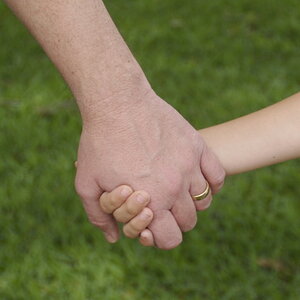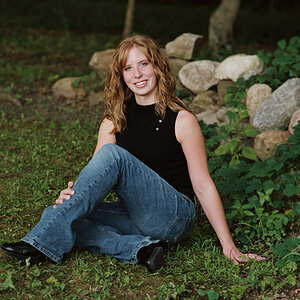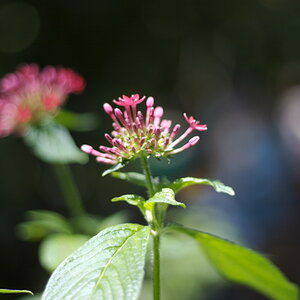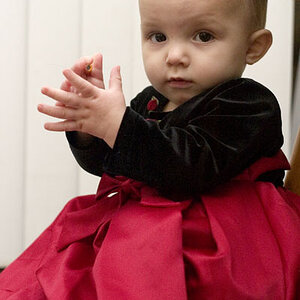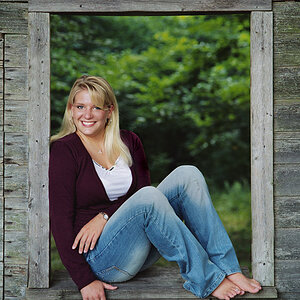amolitor
TPF Noob!
- Joined
- May 18, 2012
- Messages
- 6,320
- Reaction score
- 2,131
- Location
- Virginia
- Can others edit my Photos
- Photos OK to edit
I wrote this for my blog, but it's one of those rare topics that falls into the overlap between things I write for my blog, and things I write for TPF, so I am just copying it here.
There is a device called the color wheel. This is, essentially, the colors of the rainbow in rainbow-order wrapped around a circle with the red end and the purple end connected together. Whether you proceed red-orange-yellow-etc in the clockwise or counter direction varies. How the colors are spaced varies, which means that which color is opposite which other color can vary a bit. The point is, though, that for any color there are colors that are close to it on the color wheel and there are colors that are far apart on the wheel. Some color wheels represent saturation as well, as a distance from the center. The center is white, the rim of the wheel has very saturated hues, and so on.
Colors that are opposite one another on the color wheel are called complementary but this notion depends, obviously, on the wheel. I will use the word complementary instead to simply mean that two colors are very far apart on the wheel. Blue/orange, green/red, yellow/purple, these are complementary. Also, however, Purple/orange, or green/violet, or yellow/purple might be considered complementary. I am being somewhat naughty here, since complementary really does mean something specific, it just happens to depend on your color model.
A quick web search will turn up loads of pictures and examples of this sort of thing. You can start here: Color wheel - Wikipedia, the free encyclopedia
When I say a narrow palette of colors, I mean a collection of colors drawn from close together on the color wheel, colors that are similar in hue. However, generally, I mean that they are similar in value and saturation as well, although a certain amount of variation is permitted here. A narrow palette of colors "goes together" in general terms. A collection of muted oranges, reddish-yellows, and warm browns might form such a narrow palette, for instance.
By far the most common color design in fashion photography and, interestingly enough, high end landscape art, uses two narrow palettes which are complementary. One is dominant, and provides colors for most of the frame, while the other is subordinate and colors a smaller percentage of the frame area. The subordinate color palette is an accent color.
Some people will talk about patterns of three colors or palettes, or even four, evenly spaced around the color wheel. Again, since color wheels vary, these colors will depend on which wheel we're talking about. In addition, we start talking about exceedingly narrow palettes, or even single colors, here, otherwise the palettes overlap and we simply have all available hues and there is, in reality, no plan. I don't notice this occurring much in real work, to be honest, but perhaps it's out there. I think that these ideas tend to either disintegrate or to be read as simple a "riot of colors" idiom, which can certainly be successful.
Let us, therefore, return to the two-palette theme.
Once you recognize the pattern and know what to look for, you will start to see it everywhere. It is perhaps too much to say that it is the single most important thing nobody ever tells you about marketable photography, but there are moments when this seems to be true. Look up, for example, Peter Lik's landscapes, or look at almost literally any color fashion photograph at all. Gucci, Prada, YSL. Guess and Levis maybe not so much, but even there, I think. Ignore the blacks, greys and whites, they don't count.
The dominant palette pulls the frame together. It creates a very coherent look, the frame feels controlled and "put together". Ideally, the dominant palette colors the things you want to emphasize, the dress, the model's hair, the sand dune. A single palette can work by itself, but tends toward visually dull. The subject matter or the graphical properties of the frame better be pretty interesting. With an accent palette in play, you get visual interest for free.
At this point you can use the accent palette to manage the frame a bit. By saturating those accent colors, you can draw the eye to those accented regions. Fashion, both as worn and as photographed, does this a lot. The shoes, the clutch, and the lipstick are popped reds to draw attention, as well as to complement the navy blue dress and hat. Alternatively, the accent colors can be desaturated and muted, to push them into the background, to simply add a little visual depth and flavor to the picture. In this case, you might saturate, brighten, or use graphical techniques to draw the eye to whatever it is in the dominant palette that you want to be visually important.
With modern digital editing tools it is trivial to select areas and to adjust hues and saturations within them. It is somewhat startling how far you can go here without making the picture look unreal. You can apply much more radical changes to hue and saturation that you can to values. I strongly advocate for using the hue and saturation equivalents of burning and dodging, and I am practically certain that most successful commercial work uses these ideas extensively. If they're not using them in post, they're doing much the same thing by gelling lights.
While these ideas are certainly dominant in landscape and fashion, there's no reason event photographers and other commercial workers cannot use the same ideas. Put the bridesmaids up against complementary background, or otherwise use a complementary color palette. If you can't make it happen in camera, at least do some adjustments in post.
I wouldn't recommend messing with the dress colors, though. The bride's gonna notice that.
There is a device called the color wheel. This is, essentially, the colors of the rainbow in rainbow-order wrapped around a circle with the red end and the purple end connected together. Whether you proceed red-orange-yellow-etc in the clockwise or counter direction varies. How the colors are spaced varies, which means that which color is opposite which other color can vary a bit. The point is, though, that for any color there are colors that are close to it on the color wheel and there are colors that are far apart on the wheel. Some color wheels represent saturation as well, as a distance from the center. The center is white, the rim of the wheel has very saturated hues, and so on.
Colors that are opposite one another on the color wheel are called complementary but this notion depends, obviously, on the wheel. I will use the word complementary instead to simply mean that two colors are very far apart on the wheel. Blue/orange, green/red, yellow/purple, these are complementary. Also, however, Purple/orange, or green/violet, or yellow/purple might be considered complementary. I am being somewhat naughty here, since complementary really does mean something specific, it just happens to depend on your color model.
A quick web search will turn up loads of pictures and examples of this sort of thing. You can start here: Color wheel - Wikipedia, the free encyclopedia
When I say a narrow palette of colors, I mean a collection of colors drawn from close together on the color wheel, colors that are similar in hue. However, generally, I mean that they are similar in value and saturation as well, although a certain amount of variation is permitted here. A narrow palette of colors "goes together" in general terms. A collection of muted oranges, reddish-yellows, and warm browns might form such a narrow palette, for instance.
By far the most common color design in fashion photography and, interestingly enough, high end landscape art, uses two narrow palettes which are complementary. One is dominant, and provides colors for most of the frame, while the other is subordinate and colors a smaller percentage of the frame area. The subordinate color palette is an accent color.
Some people will talk about patterns of three colors or palettes, or even four, evenly spaced around the color wheel. Again, since color wheels vary, these colors will depend on which wheel we're talking about. In addition, we start talking about exceedingly narrow palettes, or even single colors, here, otherwise the palettes overlap and we simply have all available hues and there is, in reality, no plan. I don't notice this occurring much in real work, to be honest, but perhaps it's out there. I think that these ideas tend to either disintegrate or to be read as simple a "riot of colors" idiom, which can certainly be successful.
Let us, therefore, return to the two-palette theme.
Once you recognize the pattern and know what to look for, you will start to see it everywhere. It is perhaps too much to say that it is the single most important thing nobody ever tells you about marketable photography, but there are moments when this seems to be true. Look up, for example, Peter Lik's landscapes, or look at almost literally any color fashion photograph at all. Gucci, Prada, YSL. Guess and Levis maybe not so much, but even there, I think. Ignore the blacks, greys and whites, they don't count.
The dominant palette pulls the frame together. It creates a very coherent look, the frame feels controlled and "put together". Ideally, the dominant palette colors the things you want to emphasize, the dress, the model's hair, the sand dune. A single palette can work by itself, but tends toward visually dull. The subject matter or the graphical properties of the frame better be pretty interesting. With an accent palette in play, you get visual interest for free.
At this point you can use the accent palette to manage the frame a bit. By saturating those accent colors, you can draw the eye to those accented regions. Fashion, both as worn and as photographed, does this a lot. The shoes, the clutch, and the lipstick are popped reds to draw attention, as well as to complement the navy blue dress and hat. Alternatively, the accent colors can be desaturated and muted, to push them into the background, to simply add a little visual depth and flavor to the picture. In this case, you might saturate, brighten, or use graphical techniques to draw the eye to whatever it is in the dominant palette that you want to be visually important.
With modern digital editing tools it is trivial to select areas and to adjust hues and saturations within them. It is somewhat startling how far you can go here without making the picture look unreal. You can apply much more radical changes to hue and saturation that you can to values. I strongly advocate for using the hue and saturation equivalents of burning and dodging, and I am practically certain that most successful commercial work uses these ideas extensively. If they're not using them in post, they're doing much the same thing by gelling lights.
While these ideas are certainly dominant in landscape and fashion, there's no reason event photographers and other commercial workers cannot use the same ideas. Put the bridesmaids up against complementary background, or otherwise use a complementary color palette. If you can't make it happen in camera, at least do some adjustments in post.
I wouldn't recommend messing with the dress colors, though. The bride's gonna notice that.


![[No title]](/data/xfmg/thumbnail/41/41757-2c3d7911242848ab00e3e9aaafa24381.jpg?1619739882)
![[No title]](/data/xfmg/thumbnail/37/37518-fb05b52482bd05e84fb73316ba1a9c8f.jpg?1619738128)
![[No title]](/data/xfmg/thumbnail/32/32155-5dfb2c8aee58498ba1862d4f34389669.jpg?1619735234)
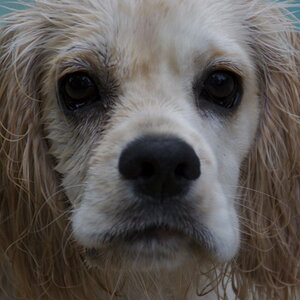
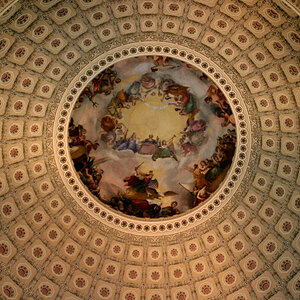
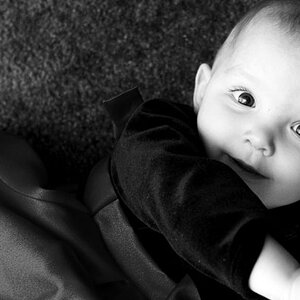
![[No title]](/data/xfmg/thumbnail/38/38263-ad5e4c9e677626ddb5b1e7cdf9ebe40e.jpg?1619738548)
